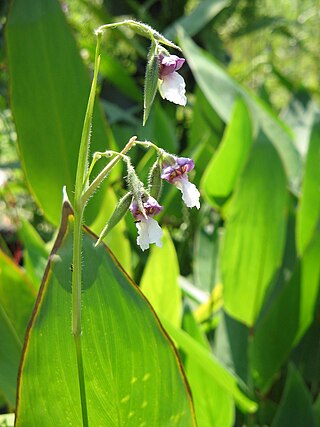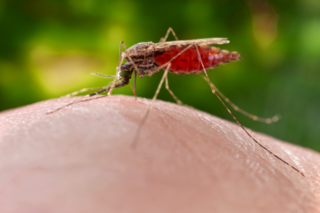
Anopheles is a genus of mosquito first described by J. W. Meigen in 1818, and are known as nail mosquitoes and marsh mosquitoes. Many such mosquitoes are vectors of the parasite Plasmodium, a genus of protozoans that cause malaria in birds, reptiles, and mammals, including humans. The Anopheles gambiae mosquito is the best-known species of marsh mosquito that transmits the Plasmodium falciparum, which is a malarial parasite deadly to human beings; no other mosquito genus is a vector of human malaria.

Plasmodium ovale is a species of parasitic protozoon that causes tertian malaria in humans. It is one of several species of Plasmodium parasites that infect humans, including Plasmodium falciparum and Plasmodium vivax which are responsible for most cases of malaria in the world. P. ovale is rare compared to these two parasites, and substantially less dangerous than P. falciparum.

Anopheles culicifacies is a mosquito species complex and one of the primary vectors of malaria on the Indian subcontinent. It consists of five sibling species, provisionally designated as species A, B, C, D, and E. It prefers to rest indoors in cattle sheds, where it feeds on cattle. The control of A. culicifacies has become difficult due to the development of insecticide resistance against all commonly used insecticides, including new-generation insecticides such as synthetic pyrethroids.

Anopheles earlei is a small insect found throughout North America. The Anopheles earlei larvae are found in cold, clear water in ponds and other small bodies of water that contain plant life or vegetation.

Anopheles is a genus of mosquitoes (Culicidae) with about 484 recognised species.
Plasmodium fieldi is a parasite of the genus Plasmodium sub genus Plasmodium found in Malaysia. This species is related to Plasmodium ovale and Plasmodium simiovale. As in all Plasmodium species, P. fieldi has both vertebrate and insect hosts. The vertebrate hosts for this parasite are primates.

Thalia geniculata, the bent alligator-flag, arrowroot, or fire-flag, is a plant species widespread across tropical Africa and much of the Americas.
The Walter Reed Biosystematics Unit ("WRBU") is a US Army organization that conducts laboratory and field research on the systematics of medically important arthropods in support of epidemiological investigations and disease prevention and control strategies of importance to the military. Research is carried out worldwide, within geographic or faunistic restrictions of the material available and military requirements. Research efforts focus on the development of accurate and reliable means of identifying vectors of arbopathogens of humans.
Lutzia is a genus of mosquitos. First described in 1903 by Frederick Vincent Theobald, it includes species whose larval stages exhibit predatory behavior. The type species is Lutzia bigoti.

Anopheles freeborni, commonly known as the western malaria mosquito, is a species of mosquito in the family Culicidae. It is typically found in the western United States and Canada. Adults are brown to black, with yellow-brown hairs and gray-brown stripes on the thorax. Their scaly wings have four dark spots, which are less distinct in the male.
Anopheles nuneztovari is a species of mosquito in the order Diptera native to South America. The species was named by its discoverer, Arnoldo Gabaldón, to honor the Venezuelan entomologist Manuel Núñez Tovar.
Anopheles bellator is a species of mosquito mainly located in southeast of State of São Paulo, Brazil, is a main vector of malaria.

Anopheles maculipennis is a species of mosquito that can be found mostly in Europe and New Zealand. It is one of the main vectors of malaria.
Anopheles moucheti is a species of mosquito. It is an anthropophile. It can be mainly located in Congo Basin forest, Central Africa. It was the main vector of malaria.

Anopheles merus is a species of mosquito that can be found in coastal areas of Eastern and Southern Africa. The species is a main vector of malaria.

Anopheles quadriannulatus is a species of mosquito that can be found in Sub-Saharan Africa with the exception of West Africa and Madagascar. The species is a vector of malaria.

Anopheles farauti is a species of mosquito that is an important malaria vector occurring in Papua New Guinea, neighbouring islands and Australia. A. farauti is common in coastal areas and breeds in brackish water rich in organic matter. It is often found in coastal swamps and mangrove forests.

Anopheles plumbeus is a species of mosquito found in Europe and can also be found in the near East and northern Africa. It is anthropophilic and can be a nuisance mosquito, biting persistently during dawn, dusk and also during the day. A. plumbeus can transmit the malaria agent Plasmodium falciparum. A. plumbeus has been collected from forested areas, but also from rural and urban areas. It breeds in treeholes, water-filled containers or discarded tyres. The species is similar in appearance to A. claviger.











